Thursday, October 27th 2011

Gigabyte X79 UD3 and UD5 Final Design Motherboards Detailed
Here are pictures of the release-grade revision (1.0) of Gigabyte's socket LGA2011 motherboards in its main linuep, the GA-X79-UD3 and GA-X79-UD5. These are the release-grade 1.0 revisions, that are redesigned for X79 chipset with just six SATA ports (doing away with SAS). With the LGA2011 motherboard lineup, Gigabyte is doing away with the "UD7" model, in its segment there is GA-X79-OC. We saw this coming, because UD7 was meant to be an overclocking motherboard identifier. On the company website, for example, the product page of GA-X58A-UD7 (2.0) shows GA-X58A-OC as a "newer model". The GA-X79-UD3 is poised to be the most affordable LGA2011 motherboard from Gigabyte, while the GA-X79-UD5 offers some premium connectivity and memory expansion features.
The GA-X79-UD3 uses a simple 8+1 phase VRM to power the LGA2011 CPU. The memory is powered by a 4-phase VRM. There are just four DDR3 DIMM slots, one per channel. There are four PCI-Express 3.0 x16 slots, among which two are x16 capable, and all four are x8 capable. There are two PCIe x1, and surprisingly, a legacy PCI slot (uncommon for LGA2011 platform). All six SATA ports from the X79 chipset are assigned as internal ports: two SATA 6 Gb/s (white), and four SATA 3 Gb/s (black). Three Marvell-made SATA 6 Gb/s controllers provide four additional internal ports (gray), and two eSATA 6 Gb/s. There are just four USB 3.0 ports, two on the rear panel, and two via internal header. 8+2 channel HD audio, a number of USB 2.0 ports, and one gigabit Ethernet connection make for the rest of the GA-X79-UD3.The GA-X79-UD5, on the other hand, uses a different PCB from that of the UD3, with more room for memory expansion thanks to eight DDR3 DIMM slots (two per channel). It uses a beefier CPU VRM, with 14-phases and POSCAP capacitors. Again, the memory is powered by a 4-phase VRM. Unlike the UD3, the GA-X79-UD5 compromises with expansion slots. The UD3 uses all seven expansion slot bays on an ATX case, but the UD5 uses just six. What's more surprising here is that the scapegoat isn't the legacy PCI slot, but a PCI-Express 3.0! This board, unlike the UD3, has just three PCI-Express 3.0 x16 slots, among which two are x16 capable, and all three are x8 capable. Storage connectivity is similar to the UD3, with two SATA 6 Gb/s (white), and four SATA 3 Gb/s (black) from the X79 PCH, four additional SATA 6 Gb/s ports (gray) and two eSATA 6 Gb/s ports from Marvell-made controllers. It has the same number of USB 3.0 ports as the UD3: 2 (rear) and 2 (header). Other connectivity is identical, except that this board also has Firewire.
Source:
OCaholic.ch
The GA-X79-UD3 uses a simple 8+1 phase VRM to power the LGA2011 CPU. The memory is powered by a 4-phase VRM. There are just four DDR3 DIMM slots, one per channel. There are four PCI-Express 3.0 x16 slots, among which two are x16 capable, and all four are x8 capable. There are two PCIe x1, and surprisingly, a legacy PCI slot (uncommon for LGA2011 platform). All six SATA ports from the X79 chipset are assigned as internal ports: two SATA 6 Gb/s (white), and four SATA 3 Gb/s (black). Three Marvell-made SATA 6 Gb/s controllers provide four additional internal ports (gray), and two eSATA 6 Gb/s. There are just four USB 3.0 ports, two on the rear panel, and two via internal header. 8+2 channel HD audio, a number of USB 2.0 ports, and one gigabit Ethernet connection make for the rest of the GA-X79-UD3.The GA-X79-UD5, on the other hand, uses a different PCB from that of the UD3, with more room for memory expansion thanks to eight DDR3 DIMM slots (two per channel). It uses a beefier CPU VRM, with 14-phases and POSCAP capacitors. Again, the memory is powered by a 4-phase VRM. Unlike the UD3, the GA-X79-UD5 compromises with expansion slots. The UD3 uses all seven expansion slot bays on an ATX case, but the UD5 uses just six. What's more surprising here is that the scapegoat isn't the legacy PCI slot, but a PCI-Express 3.0! This board, unlike the UD3, has just three PCI-Express 3.0 x16 slots, among which two are x16 capable, and all three are x8 capable. Storage connectivity is similar to the UD3, with two SATA 6 Gb/s (white), and four SATA 3 Gb/s (black) from the X79 PCH, four additional SATA 6 Gb/s ports (gray) and two eSATA 6 Gb/s ports from Marvell-made controllers. It has the same number of USB 3.0 ports as the UD3: 2 (rear) and 2 (header). Other connectivity is identical, except that this board also has Firewire.
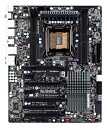
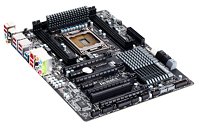
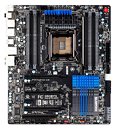
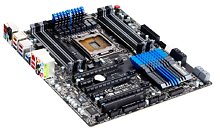
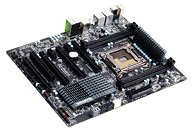
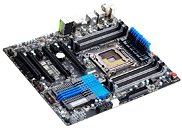
63 Comments on Gigabyte X79 UD3 and UD5 Final Design Motherboards Detailed
btw bright color with dark color is nice so it looks more attractive :D
maybe Gigabyte need to learn from ASUS how to match them
basing on Gigabyte's previous MB success, i can see that UD3 on most new wishlists.
and OH how about those sata ports perpendicular to the board.
a win for me.
As for RAM slots... you don't need more than four of them, unless you're building a workstation using this board. For the lifetime of this board, having 4 slots and the ability of using up to 32GB of RAM is more than enough, even for light to medium 'workstation' class usage.
More is not better, more is just a way for them to charge buyers more money for something that most of them won't ever use.
If you're using it for gaming, you're not going to use all eight slots anyway, you're going to use four of them with a max of 16GB RAM. Because for the lifetime of the X79 chipset boards, that will be more than enough for gaming, probably still overkill for gaming.
Plus, 8 slots makes 32GB easy and cheap with 4GB sticks instead of 8GB, which there are less options regarding speed, timings, and color.
I heard EVGA was making a come back in the mobo department.
The SR-3 looks pretty interesting from the sneak peaks I saw, if it is indeed real.
sr-3 is real. those shots are from jacob. but there's zero use for us to have a dual cpu board. compare a good a x58 to the sr-2, it gets trumped. unless you do rendering and calculations, there's no use for it
Also, AMD fanboy? lolwhat? You must be new to this forum.
Do you mean AMD CPU's? Because I don't own any (well I have an FX chip on order, but that's just for testing). My main CPU's are an i7 970 and an i7 950 in my home machines. So I'm not really sure where you are pulling these fantasies from. You obviously are a bit worked up, so I will just disregard the trolling.
You are pretty far off in fantasy land now with your posts, and I honestly can't understand anything past the first sentence.
Anyhow, I just wanted you to explain WHY the G1 boards addons (nic, sound) were "garbage". Please explain. Thanks.